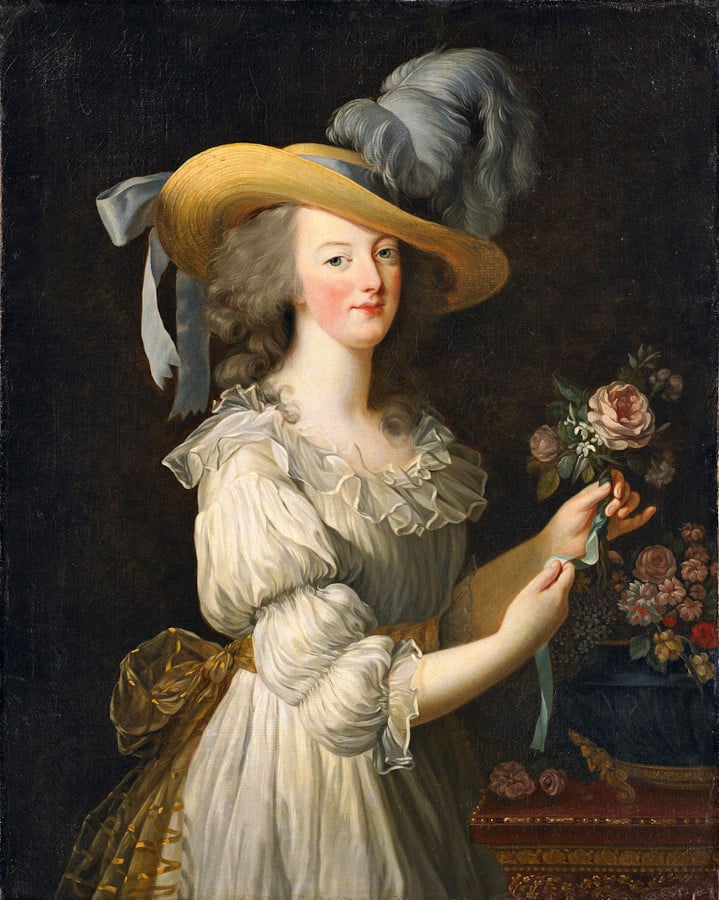Élisabeth Louise Vigée Le Brun was born in Paris in 1755. She was already painting professionally as a teenager—thanks to instruction from her father, the portrait artist Louis Vigée—despite living at a time when very few women became respected professional artists. When her work was exhibited in the 1774 Salon of the Académie de Saint-Luc (without them realizing her studio had been shut down due to her practicing without an official license), she was accepted as a member at the age of 19.
Her family background and her 1776 marriage to the art dealer Jean-Baptiste-Pierre Le Brun helped Élisabeth build a portfolio of wealthy and influential patrons. None would be as closely associated with the artist as Queen Marie Antoinette, wife of King Louis XVI. Vigée Le Brun was just 23 when she first painted Marie Antoinette, and she would create at least 30 portraits of the Queen.
In fact, it was thanks to pressure from the King and Queen that Vigée Le Brun ultimately gained entry into the Académie royale de peinture et de sculpture in 1783. At that time, just four spots were open to female artists every year, and only 15 women had been granted full membership between the academy’s foundation in 1648 and 1793.
But, like any trailblazer, Vigée Le Brun’s work upset a few people along the way. Her 1789 self-portrait with her daughter Jeanne—known as Julie and nicknamed “Brunette”—sent shockwaves through the artist’s respectable French audiences because of something surprising: her smile. It was the fashion at the time that portraits would be painted with their sitters’ mouths closed, but Vigée Le Brun had painted herself and her nine-year-old daughter mouth-open, with teeth and gums on display.
Writing about another mother-daughter portrait Vigée Le Brun had made in 1879, in which the artist shows a sliver of a smile, the gossip-sheet Mémoires secrets said: “An affectation which artists, art-lovers and persons of taste have been united in condemning, and which finds no precedent among the Ancients, is that in smiling, [Madame Vigée LeBrun] shows her teeth”.

Élisabeth Louise Vigée Le Brun, Marie Antoinette in a Chemise Dress (1783). Kronberg: Hessische Hausstiftung. Source: The Met
And that wasn’t the only time Vigée Le Brun would shock her audience, either. The artist’s 1783 portrait of Marie Antoinette wearing a Chemise Dress caused outrage because of the informal way she depicted the Queen, wearing a loose-fitting dress that couldn’t be further from the monarch’s usual attire. The portrait was swiftly removed from the Salon and Vigée Le Brun painted a second version with the queen in a more formal silk number.
On another occasion, while the artist had fled France during the French Revolution (during which Vigée Le Brun was considered an enemy because of her support of the monarchy), she was forced to add sleeves to a portrait of the Russian royal family when the Empress, Catherine the Great of Russia, was shocked by her granddaughters’ bare arms.
Despite the controversies, when the artist died in 1842, aged 86, she had built herself a legacy that would last the ages.
What’s the deal with Leonardo’s harpsichord-viola? Why were Impressionists obsessed with the color purple? Art Bites brings you a surprising fact, lesser-known anecdote, or curious event from art history. These delightful nuggets shed light on the lives of famed artists and decode their practices, while adding new layers of intrigue to celebrated masterpieces.
Follow Artnet News on Facebook:






